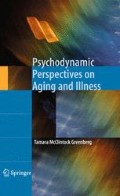Abstract
Throughout this book, I have attempted to describe various aspects of emotional experience related to the process of aging and illness. Although the patients whose case histories I have discussed portray varied levels of psychological functioning, different personalities, character structures and defenses, there is one major theme that is common to all of them: the difficulty in accessing an emotional language due to the concrete demands of bodily illness or concrete focus on the body.
While I have described how ageism, and the fear of illness or death on the part of therapists may explain the hesitation of traditional psychoanalysts in addressing the needs of medically ill and older patients, the challenges that these patients bring to the therapeutic setting in talking about their internal and mental experiences creates unique difficulties for working with this population. In this chapter, we will revisit the concept of alexithymia; I will suggest that this idea can be expanded and applied to our work as clinicians, but without the pejorative connotations that are often associated with the dilemma of lacking the right words to describe feelings, or the assumption that illness is psychosomatic. I have argued that traditional approaches are not useful for many medical and aging patients; I will also describe how we might understand aspects of the therapeutic encounter with this population. Finally, I will contextualize the hope and grief our patients face, with a focus on the resilience of the elderly and medical patients, as these individuals often want to learn ways they can expand their emotional landscape towards a more nuanced and developed internal dialogue. The quest for meaning and insight in these patients implores us to continue to find ways to connect with and help this growing population.
Access this chapter
Tax calculation will be finalised at checkout
Purchases are for personal use only
References
Alpert, J. L. (1994). Analytic reconstruction in the treatment of an incest survivor. Psychoanalytic Review, 81, 217–235.
Bion, W. R. (1962). Learning from experience. London: Tavistock.
Bion, W. R. (1970). Attention and interpretation: A scientific approach to insight in psychoanalysis and groups. London: Tavistock.
Bouchard, M. A, Lecours, S., Tremblay, L. M., Target, M., Fonagy, P., Schachter, A., et al. (2008). Mentalization in adult attachment narratives: Reflective functioning, mental states and affect. Psychoanalytic Psychology, 25(1), 47–66.
Breuer, J., & Freud, S. (1957). Studies on hysteria (J. Strachey, Ed & Trans.). London: Hogarth Press. (Original work published in 1895)
Ferro, A. (2002). In the analyst's consulting room (P. Slotkin, Trans.). New York: Taylor & Francis.
Fonagy, P., & Target, M. (2000). Playing with reality III: The persistence of dual psychic reality in borderline patients. International Journal of Psychoanalysis, 81, 853–873.
Glucksman, M. L. (2000). Affect dysregulation: Defense or deficit? Journal of the American Academy of Psychoanalysis, 28, 263–273.
Gill, M. M. (1984). Transference: A change in conception or only in emphasis? A response. Psychoanalytic Inquiry, 4, 489–524.
Guttman, S. R. (2006).Hysteria as a concept: A survey of its history in the psychoanalytic literature. Modern Psychoanalysis, 31, 182–228.
Jaques, E. (1998). Death and the mid-life crisis. In E. B. Spillus (Ed.), Melanie Klein today: Developments in theory and practice (Vol. 2, pp. 226–248). London/New York: Routledge.
Joseph, B. (1983). On understanding and not understanding: Some technical issues. International Journal of Psychoanalysis, 64, 291–298.
Klein, M. (1940). Mourning and its relation to manic-depressive states. International Journal of Psychoanalysis, 21, 125–153.
Krystal, H. (1997). The trauma of confronting one's vulnerability and death. In C. Ellman & J. Reppen (Eds.), Omnipotent fantasies and the vulnerable self (149–185). Northvale, NJ: Jason Aronson.
Krystal, H. (1988). Integration and self-healing: Affect-trauma-alexithymia. Hillsdale, NJ: The Analytic Press.
McDougall, J. (1980). A child is being eaten, I: Psychosomatic states anxiety neurosis, and hysteria. Theoretical approach II: The abysmal mother and the cork child- a clinical illustration. Contemporary Psychoanalysis, 16, 417–459.
McDougall, J. (1989). Theaters of the body. New York: Norton.
McDougall, J. (1984). The “dis-affected” patient: Reflections of affect pathology. Psychoanalytic Quarterly, 53, 386–409.
Miller, M. L. (2008). The emotionally engaged analyst I: Theories of affect and their influence on therapeutic action. Psychoanalytic Psychology, 25(1), 3v25.
Mitchell, S. A. (1993). Hope and dread in psychoanalysis. Cambridge: Harvard University Press.
Nemiah, J. C. (1973). Psychology and psychosomatic illness: Reflections on theory and research methodology. Psychotherapy and Psychosomatics, 22, 106v111.
Rickles, W. H. (1986). Self psychology and somatization: An integration with alexithymia. Progress in Self Psychology, 2, 212–226.
Renik, O. (1996). The perils of neutrality. Psychoanalytic Quarterly, 65, 495–517.
Schore, A. (1994). Affect regulation and the origin of the self: The neurobiology of emotional development. Hillsdale: Erlbaum.
Schore, A. (2002). Advances in neuropsychoanalysis, attachment theory, and trauma research: Implications for self psychology. Psychoanalytic Inquiry, 22, 433–484.
Schwartz, J. M., & Stolorow, R. D. (2001) Trauma in a presymbolic world. Psychoanalytic Psychology, 18, 380–387.
Seligman, S. (2000). Clinical implications of current attachment theory. Journal of the American Psychoanalytic Association, 48, 1189–1194.
Sifneos, P. E. (1973). The prevalence of “alexithymic” characteristics in psychosomatic patients. Psychotherapy and Psychosomatics, 22(2), 255–262.
Winnicott, D. W. (1965). The maturational process and the facilitating environment. New York: International Universities Press.
Zackheim, L. (2007). Alexithymia: Expanding the realm of research. Journal of Psychosomatic Research, 63, 345–347.
Zinberg, N. E. (1964). Psychoanalytic consideration of aging. Journal of the American Psychoanalytic Association, 12, 151–159.
Author information
Authors and Affiliations
Corresponding author
Rights and permissions
Copyright information
© 2009 Springer Science+Business Media, LLC
About this chapter
Cite this chapter
Greenberg, T.M. (2009). Hope and Grief: The Introduction of an Emotional Language. In: Psychodynamic Perspectives on Aging and Illness. Springer, New York, NY. https://doi.org/10.1007/978-1-4419-0286-3_9
Download citation
DOI: https://doi.org/10.1007/978-1-4419-0286-3_9
Published:
Publisher Name: Springer, New York, NY
Print ISBN: 978-1-4419-0285-6
Online ISBN: 978-1-4419-0286-3
eBook Packages: Behavioral ScienceBehavioral Science and Psychology (R0)

